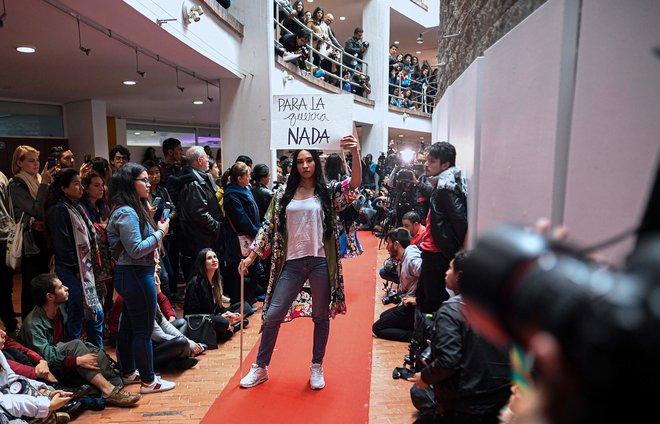FARC former guerrillas show their first fashion collection in a pazarela
Although in the thick Colombian jungles where they fought for years they used to walk stealthy in a row and manufacture their own uniforms in improvised workshops, 22 ex -combatants of the FARC never thought that experience would help them now venture into the glamorous fashion world with a "Pazarla ".
They, who after the signing of the Peace Agreement in 2016 between the Government and the guerrillas saw the real opportunity to create their first collection of clothing other than the traditional camouflaged uniforms they used, had a novel test of fire on Wednesday.
"From the war to the pazarela" is the name of the fashion parade with which the group of demobilized settled in the territorial space for training and reinstatement (ETCR) of the row, located in the municipality of Icononzo, in the central department ofTolima, announced their creative proposal at the University of Los Andes, in Bogotá.
Before the expectant look of the attendees - among whom there were students, teachers, bloggers, journalists and influencers - the former guerrillas, who are part of the multiactive cooperative of the common one weaving peace, presented kimonos in satin and acetate, dresses, vests, skirts andPrinted shirts.
The process to elaborate this collection was part of Ángela María Herrera, who despite having studied political science is considered a "passionate about fashion."

"It has been a rewarding job. I have demystified the prejudices that I had around the demobilized population and now I think that weapons are the least because the important thing has been the desire to fight them against injustices and inequality,"The 24 -year -old designer told Efe.
With his entrepreneurship "Manifest. Made in Colombia", Herrera arrived in Icononzo convinced that "the way to contribute to the construction of peace was through the generation of decent jobs for those who wielded a weapon."
In this way he helped the ex -combatants to give life to the brand "Tombaz", for which she and other volunteers put on the reconciliation shirt with the purpose of "defending a process of leaving arms that many see with disbelief."
In the row, a place where 288 ex -guerrillas live, Jimmy Rodríguez is one of those in charge of operating the flat machines and the fillet.
During the 21 years that his work was raised in arms, he consisted of sewing the uniforms and that was his starting point to know that in peace times he could exercise the same trade.
"On the mountain we had workshops in which we made the uniforms and since I had an idea about clothing it was easy for me now to make fashion clothes," Rodríguez said.
The ex -combatant, who at 43 is the father of a girl of 2, hopes that the collection will be accepted and can become his "livelihood."
The same thinks Gonzalo Beltrán, manager of the Multiactive Cooperative of the Common Teaming Paz, for whom learning to sew was one of his "most difficult battles."
But as in the course of the more than 50 years of armed conflict that starred in the FARC and the public force they learned that "he who knows he teaches the one who does not" began to train in design, cut and clothing with the 12 sewing machinesThey are in operation, a fillet, a flat and a special to stamp that they acquired with their own resources.
That "mission" has not been easy, since according to Beltrán "grabbed the rhythm to the machine is complicated."
"The important thing is not to stop insisting and rehearse," he said.
With the sale of the garments, whose price ranges between 25,000 and 78,000 and pesos (between 7 and 23 dollars), they want to recover the investment of 600,000 pesos (about 177 dollars) that each one did and give visibility to the project.
Beltrán, who was 14 years in the jungles of the Meta and Guaviare departments with the FARC, did not imagine venturing into fashion.
In spite of this, he clarified that since the dialogues began in Havana, the combatants were "prepared to assume the challenge that came" because they knew they were "going to pass from one form of struggle to another more complex."
In addition, added the ex -combatant of 42 years, "it was always said that the idea was to look for an exit to the conflict through the dialogue and we add something fashionable to embellish even more this peace."
Claudia Polanco Yermanos
